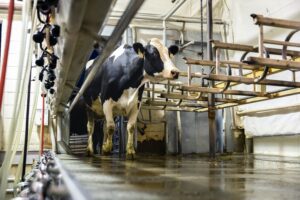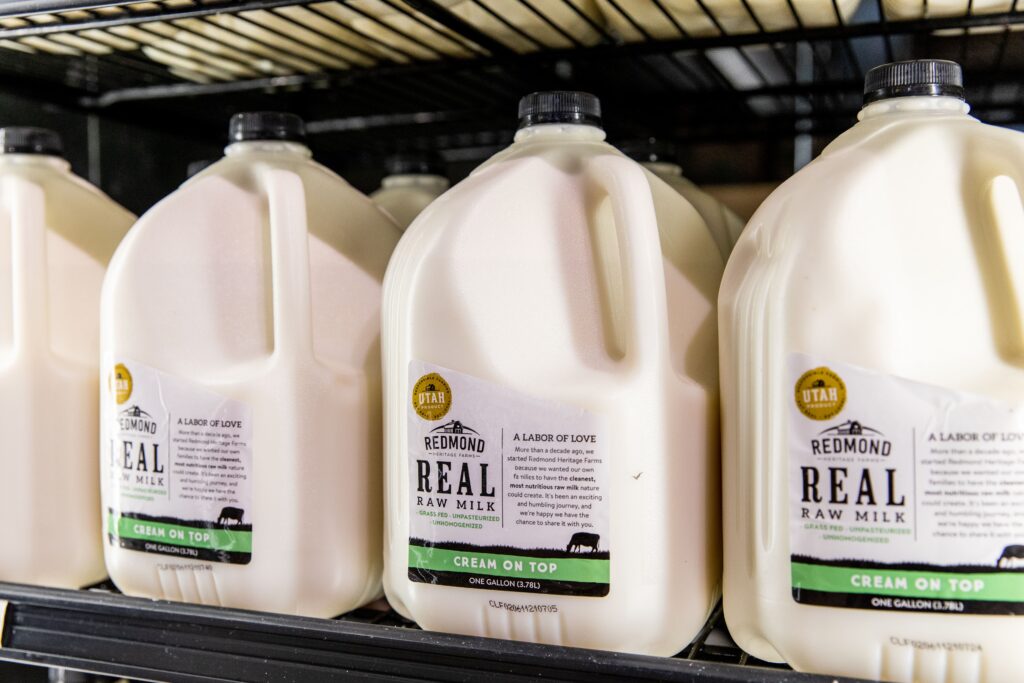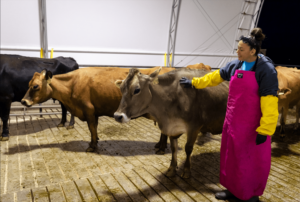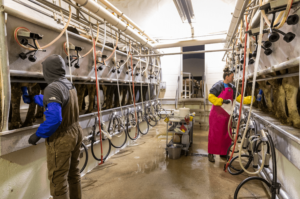If you’ve been a Redmond Farm customer for long, you might walk into our stores on occasion only to find our milk shelves empty.
What gives? Why don’t we always have fully-stocked shelves like a regular grocery store?
The truth is, our high-quality standards for the care of our cows sometimes mean that milk production fluctuates. After all, we’re not a factory farm with a massive herd. (And we don’t want to be.)
Instead, we strive to work with nature, not against it. Our #1 goal is for our cows to be happy and healthy because we love them, and also because unhappy, unhealthy cows can’t produce the quality of milk we’re looking for.
We don’t compromise our standards!
Here’s a closer look at the factors that play into the ebbs and flows of our milk production, and why we sometimes run out of our raw milk.
4 Factors That Affect Our Milk Production
 #1: Temperature and seasons
#1: Temperature and seasons
Our cows’ bodies have to burn energy to regulate their internal temperatures, whether that means staying cool or keeping warm.
So they have to do that AND move around AND carry pregnancies AND produce milk. That’s a lot of energy. So when temperatures are extreme, sometimes there’s just not as much energy left over for making milk. This means milk production might dip a bit in the height of summer and the coldest parts of winter.
#2: Pregnancies and natural cycles
For starters, we do our best to stagger pregnancies, but that’s not always possible. A lot of it depends on bull availability, and whether pregnancies take. (It’s not a sure thing.)
There’s also the matter of the cows’ individual cycles. Cows produce lots of milk for about a year after giving birth so they can feed the calf. (Don’t worry, we leave plenty of milk for the baby!)
We give them a dry period of about three months to rest, eat, and get a little chubby before we breed them again and the cycle starts over.
This is one area where we don’t compromise on our girls’ health. We could skip that dry period if we wanted to. But we don’t because it’s healthier for them to take a break, even if it means less milk for us.
#3: Hormones and antibiotics
Factory farms typically give their cows artificial hormones to increase milk production, but we don’t. We let our cows be who they are and work with their natural milk production.
The bad news is that this means lower production. But the good news is that it’s healthier for our cows and for you because there are no artificial hormones in your milk!
We also give cows antibiotics ONLY when absolutely necessary to save the cow. When we do, we take them off the milk line for at least 8 months to keep the milk pure. This is another instance of prioritizing health and quality over milk quantity.
#4: Nutrition
This is a constant balancing act.
We need to feed our cows enough energy and nutrients to stay warm (or cool), to feed and grow a calf, and to stay healthy and robust while they do it.
This can get complicated because their needs change throughout the year and in different areas of their cycles. The availability of quality feed can vary too.
What we DON’T use is also an important factor. For example, we don’t feed our cows cottonseed, which most other commercial dairies use to drive milk production. It’s nearly impossible to find organic, non-GMO cottonseed that meets our standards, so we don’t use it.
So, we have to pick and choose the best feed based on what’s around. We seek out top-notch hay, barley, and supplements for our girls.
Our dairy farmers, Bryan and Jessi, even work with a hay broker–yes, that’s a thing–to find organic hay with good test analysis results. Currently, we’re partnering with a certified organic grower in Idaho.
We get our barley from IFA nutritionists and work closely with them to make sure it’s mixed in a clean bin so that we aren’t getting other unwanted ingredients.
Finally, we provide supplements to make sure our girls get the right balance of vitamins and minerals. Here are a few of our supplement standbys:
- Redmond Selenium 90 blocks to prevent vitamin deficiencies.
- Redmond Conditioner.
- Redmond Real Salt. (Regular in winter and garlic salt in summer, because garlic helps with flies!)
Only the best for our herd!
It comes down to this: our cows aren’t faucets. We can’t just turn their milk production off and on at will.
Producing the best milk possible is an art, a science, and a constant dance with nature to keep our cows healthy.
It takes an incredible amount of dedication, love, and commitment to care for our herd and keep them healthy. Bryan and Jessi know these cows individually and monitor their health closely, keeping an eye on their appearance, behavior, and (especially!) poop, then adjust their care accordingly.
And it’s paying off!
Our cows have an amazing quality of life. Most dairy cows live about 5 years, but our girls easily reach up to 15 years old, and we have 3 or 4 generations in our herd.
At the end of the day, it’s healthy cows over milk quantity. Always. We do what we do because we care about our cows, and our customers, and we believe that this is the best way to prioritize both!



